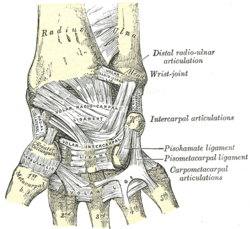Palmar radiocarpal ligament
| Volar radiocarpal ligament | |
|---|---|
 Ligaments of wrist. Anterior view. (Volar radiocarpal visible at center.) | |
| Details | |
| From | radius |
| To | proximal carpals, capitate |
| Identifiers | |
| Latin | Ligamentum radiocarpeum palmare |
| TA | A03.5.11.004 |
| FMA | 40002 |
The palmar radiocarpal ligament (anterior ligament, volar radiocarpal ligament) is a broad membranous band, attached above to the distal end of the radius, to the scaphoid, lunate and the triquetrum of the carpal bones in the wrist. Some being continued to the capitate.
In addition to this broad membrane, there is a rounded fasciculus, superficial to the rest, which reaches from the base of the styloid process of the ulna to the lunate and triangular bones.
Perforations
The ligament is perforated by apertures for the passage of vessels,
Relations
It is in relation, in front, with the tendons of the flexor digitorum profundus and flexor pollicis longus.
Behind, it is closely adherent to the anterior border of the articular disk of the distal radioulnar articulation.
Components
Some sources break down the components of the ligament as follows: radiolunate, radiocapitate, radiotriquetral, and radioscaphoid.[1]
Other sources combine the radioscaphoid and radiocapitate into a "radioscaphocapitate".[2]
References
This article incorporates text in the public domain from the 20th edition of Gray's Anatomy (1918)
- ↑ Hand kinesiology at the University of Kansas Medical Center
- ↑ Netter, Frank H. (2003). Atlas of Human Anatomy : With netteranatomy.com (Netter Basic Science). Philadelphia: Saunders. p. 454. ISBN 1-4160-3385-8.
External links
- Anatomy photo:10:st-1504 at the SUNY Downstate Medical Center